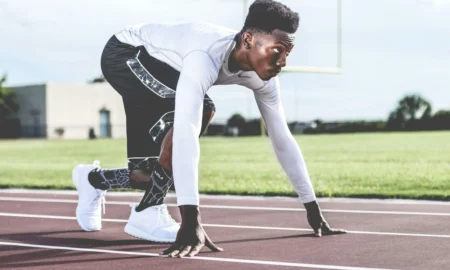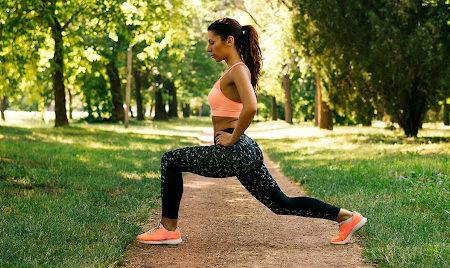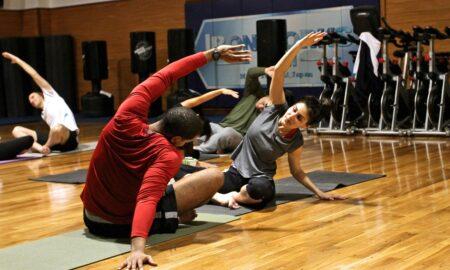Q: I’ve been training for just over a year, and my physique has improved measurably. I love to train, but I have a problem with squats, which I need to do because I have skinny legs. Every time I squat, my lower back gets very sore despite the fact that I use a belt for support. Also, I don’t really get a pump or feel any stimulation in my thighs. My lower back and glutes seem to do the most work and get the most stimulation. I’ve read articles in the magazines about the importance of keeping the back straight and as upright as possible during squats, but I find that impossible. My upper body just naturally bends forward and my back rounds over as I descend to parallel. What am I doing wrong? Do you have any advice on how to squat so my thighs get the hard work, not just my lower back and glutes?
A: First, I can tell you that you’re doing your squats improperly. What you’re experiencing is actually a pretty common problem among novice and intermediate bodybuilders. It’s also the reason Vince Gironda was so against squats and why he didn’t have squat racks in his gym. Gironda felt that barbell squats did more harm than good, and he didn’t want his members doing them. He argued that squats done the way most people do them’and that includes you’overdevelop the glutes and widen or thicken the waistline by working the obliques and spreading the hips, which reduces the V-taper. Vince also thought squats overdeveloped the upper thighs but did not develop the lower thighs enough, which created what he called ugly ‘turnip-shaped’ thighs. Vince said squats destroyed symmetry and ruined the aesthetic quality of the physique. The only people who should squat, he said, were those trainees who had flat glutes and who needed to improve them.
It doesn’t surprise me that you experience no thigh pump and no thigh stimulation as you squat because the way you squat doesn’t work the thighs. You’re just working mostly the lower back and glutes.
When a bodybuilder tries to squat with a really heavy weight, the natural tendency is to bend forward at the waist, which rounds the back. The head ducks down between the legs as if you were doing a good morning. When you ascend to the starting position, you start upward, with your head still down and your lower back still rounded.
The first half of the ascent is almost entirely a good morning. That puts tremendous pressure on your lower back and glutes. It’s one thing to work the lower back with a moderate weight doing good mornings. It’s another thing to ask the lower back to support a weight that’s meant to be lifted by the thighs. Then about halfway to two-thirds up you try to straighten your back again. It’s that rocking back and forth, with the lower back rounding over as you descend and the back straightening near the top of the rep, that really overloads the lower back and spinal erectors. I’ve seen some guys so rounded over at the bottom of a squat done as described that the barbell is no longer on the shoulders or traps; it’s on the neck and even partially on the lower part of the head.
So what’s the solution? First, reduce the weight you use by about 25 percent and increase the number of repetitions you do on each set. Next, change your mind-set from trying to see how much weight you can squat to trying to see how hard you can stimulate your thighs on each rep. You want to experience thigh isolation and all the sensations of innervation in your thighs, not your back or glutes. Squats are a compound exercise, so you’ll never get 100 percent isolation and innervation, but the majority of the overload should be felt in your quads, not the secondary and supporting muscle groups.
I suggest that you forget about trying to keep your back flat and upright. Do that when you squat using a Smith machine, not on barbell squats. Place the bar a little lower than you’re probably used to, say, across your upper traps, not your shoulders. As you get under the bar, make sure it’s centered before lifting it off the racks. Be sure the bar is evenly balanced across your traps before stepping back, one leg at a time. Keep your feet no wider than shoulder width. You may want to squat with a narrow stance, with the heels of your feet only six inches to a foot apart. You can point your feet slightly out to the sides or straight ahead. You’ll have to experiment to find the position that feels the best and works the quads hardest. Now you’re ready to squat.
First, however, we’re going to change the way you squat. Rather than trying to keep your back completely straight and upright, bend forward at the waist 10 to 15 degrees. Make sure your lower back is arched, not rounded. Keep your abs tight and lock your upper body into that slightly bent-forward position. It’s vital that you maintain that position throughout the entire set, on both the descent (negative) and ascent (positive). Lower slowly down to parallel with control; try to feel as if your lower body and legs are coiling. Then explode upward with primarily thigh power to the starting position. Never drop into the low squat position quickly and try to rebound up, as that’s a sure way to damage your knees.
What’s the point of locking into the 10-to-15-degree bent position and arched lower back? It ensures that you don’t bend forward too much and get into that undesirable good morning position at the bottom of the descent. It also ensures your lower back doesn’t round over. That will prevent your head from ducking down between your legs or your glutes coming up first as you start your ascent. If you stay locked into the starting position, there will be no rocking back and forth as you do your reps, which will greatly reduce the strain on your lower back.
As you begin the ascent, try to feel as though you’re pushing up with the heels of your feet. That forces the overload mostly on the quads, not the hips, glutes and lower back. Concentrate on trying to feel the overload and stimulation in your quads. Use higher reps’12 to 20’for the first month until you get the movement down. As your thighs gain strength and your muscular endurance increases, you can use more weight and do lower-rep sets without compromising form. I’m not saying don’t squat heavy. You must squat heavy to build larger thighs, and you must train progressively’always trying to use more weight’but squat heavy in good form.
I have two other suggestions that should help you squat heavier without compromising form. You’ve heard the phrase, ‘A chain is only as strong as its weakest link.’ It definitely holds true for bodybuilding. Weak abs and weak spinal erectors will affect how much you can squat. Your erectors often fail before the quads have been worked hard enough to cause them to grow. I suspect your lower back is pretty strong from the way you’ve been doing your squats, but you must make it even stronger. The stronger your abs and lower back, the more weight you can squat with in good form and the harder you’ll be able to work your quads.
I remember IFBB pro Henderson Thorne telling me in an interview that early in his career, after he’d been training for several years, his squat poundage was stuck at 405 pounds for 10 reps. That was as heavy as he could go, and it went on for many months. Then he began doing heavy deadlifts as part of his back routine, an exercise he had never devoted much time or effort to before. Henderson quickly realized there was a direct relationship between how much weight he could deadlift and how much he could squat.
After he did heavy, low-rep deadlifts once a week for about six months, his squat poundages just zoomed up. Soon he was doing squats with 500 pounds for 10 reps, then over the next couple of years 600 pounds for 10, and then 700 for eight. His legs became so strong that he eventually squatted 800 pounds for three reps (I witnessed that performance, so I know it’s true). Not too shabby for someone who weighed about 220 pounds! Oh, I almost forgot to mention that his thighs became massive, with huge sweeps and deep cuts. I consider Henderson one of the best squatters among pro bodybuilders, in a class with Tom Platz.
To this day Henderson still performs heavy deadlifts as part of his routine, but he makes a max attempt only about once a month (he feels it takes him a couple of weeks to recover from a maximum effort). The other three weeks he does several sets of deadlifts once a week, starting with 405 for 10 and working up to 675 pounds for six reps (seven plates per side). When he’s feeling extra strong, he works up to eight plates (765 pounds) a side for six reps. Needless to say, his back has great thickness and density. He feels that the combination of heavy squatting and heavy deadlifting greatly improved his hamstrings.
If his lower back is sore and he feels he hasn’t recovered fully from his previous deadlift workout, he drops the deadlifts for that workout and does some hyperextensions instead. I suggest you do the same. Let your body be your guide.
The second recommendation sounds like a contradiction to what I just said above, but it’s not. I suggest that on exercises such as the 45-degree leg press machine and belt squats (if your gym has the equipment) you do sets of high repetitions. By high I mean a minimum of 20 reps for a set, up to 100 reps a set. High-rep leg presses will force a lot of blood into your thighs, giving you a great pump. It will increase red muscle fibers and capillaries. It will also improve the neuromuscular pathways to the thighs, increasing thigh innervation.
Using Henderson as an example again, he usually does sets with 1,100 pounds for 30 reps. Sometimes he’ll have his training partners strip plates from the plate holders so he can do drop sets. After a couple of light warmup sets he’ll start with 1,100 pounds and do 30 repetitions. That would be enough work for most bodybuilders, but for Henderson the set has just begun. After they’ve taken a couple of plates off each side, he continues the set. He usually does triple drops, and by the time the set is over, he’s done about 100 reps and can’t even stand up for a minute or so. His thighs are just burning and pumped like balloons. He admits the pain is almost unbearable, but he believes that a combination of heavy and light training for the thighs works best and gives him the mass and muscularity he seeks.
I know from personal experience that high reps work great for both building size and improving muscular endurance. Try it after your heavy squats, and you’ll see incredible results within the first month.
You can also do preexhaust supersets for the thighs. For example, do leg extensions for 20 reps and then go right to squats. Try that on your light squat day. Or you can do leg presses for 50 reps and then go right to squats. Your thighs will be totally fried, but your lower back will still be fresh and strong. Then, when you fail with the squats, it will be because your thighs give out, not your lower back. If you’re a beast for punishment, you can do a preexhaust tri-set of high-rep leg extensions, 20 reps; leg presses, 50 reps; and squats, 20 reps. Casey Viator used to do that, and he had massive thighs. One or two tri-sets is all you’ll need. Believe me, your thighs will feel like mush, and you’ll have a hard time walking after one of those tri-sets. Don’t worry if you have to use what you may feel are ridiculously light weights on your squats. If you feel a white-hot burn in your quads and experience a massive pump, that’s all you should be shooting for.
Even the great Sergio Oliva collapsed on the floor when he did one of those preexhaust tri-sets for the first time. He’d gone down to Florida to train with Casey Viator when Casey was working with Arthur Jones. Sergio was following Casey and trying to use the same weights and reps on his preexhaust thigh tri-set exercises. He got through the leg extensions and leg presses okay, but after only a couple of reps of squats he barely racked the weight before fainting. If it was too tough for Sergio, don’t feel too bad if you find it difficult to do at first too.
John Parrillo told me that virtually every bodybuilder he’s trained in the past decade has blacked out and/or vomited the first time he had to do 100 reps on a belt squat machine. That type of training is not for the fainthearted, but if you’ve got the guts to do it, it’s very effective. IM




















You must be logged in to post a comment Login